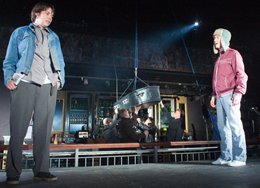Set in rural Russia following the breakup of the Soviet Union, Vassily Sigarev’s Plasticine presents an ever-sickening series of disturbing scenarios that, to its inhabitants, are seemingly experienced as banal slices of a doomed life. That’s where the play’s punches land most effectively. In spite of its gratuitous displays of rape and vulgarity, what the audience sees as desperate, horrifying, or pitiable is regarded by most of the characters as another day in a life that’s expected to get steadily worse. While this summation doesn’t exactly promise a cheering evening at the theatre, what Corcadorca’s production effectively underlines is the fact that middle class morals mean very little in a world where sex and violence, either physical or psychological, provide some of the only real contact between people who have been left behind by history.
.jpg.aspx%3Fwidth=260&height=177) Maksim (Caoilfhionn Dunne) is a teenage boy dealing with the recent suicide of a neighbourhood friend. The circumstances that drove Maksim’s friend to hang himself are never mentioned outright, though the flaying of Maksim’s innocence during the course of the play offer some clue as to the pressures that ultimately pushed his friend to take his own life. The text offers no real plot: here we see Maksim sneaking a smoke in the loo; there we see Maksim being expelled after waving a plasticine cock in front of the headmistress; and here we see Maksim being forced to go down on a drunkenly salacious woman in the street. What makes this bloody dissection of a demoralizing existence fascinating is the way in which Maksim and the other characters grudgingly accept the circumstances forced on them. When the suicide’s mother returns from life on the streets to attend his funeral, it’s as much to mourn her son as it is to take advantage of the free booze being served. There is a harsh comic heroism in the characters’ persistence to survive in the face of such indignity, as they grasp at whatever palliative will facilitate a brief escape from their living hell.
Maksim (Caoilfhionn Dunne) is a teenage boy dealing with the recent suicide of a neighbourhood friend. The circumstances that drove Maksim’s friend to hang himself are never mentioned outright, though the flaying of Maksim’s innocence during the course of the play offer some clue as to the pressures that ultimately pushed his friend to take his own life. The text offers no real plot: here we see Maksim sneaking a smoke in the loo; there we see Maksim being expelled after waving a plasticine cock in front of the headmistress; and here we see Maksim being forced to go down on a drunkenly salacious woman in the street. What makes this bloody dissection of a demoralizing existence fascinating is the way in which Maksim and the other characters grudgingly accept the circumstances forced on them. When the suicide’s mother returns from life on the streets to attend his funeral, it’s as much to mourn her son as it is to take advantage of the free booze being served. There is a harsh comic heroism in the characters’ persistence to survive in the face of such indignity, as they grasp at whatever palliative will facilitate a brief escape from their living hell.
Corcadorca transforms Cork’s Savoy Theatre, usually a nightclub and music venue, into a promenade space, where the settings and inhabitants of Maxim’s world are spread out from the traditional proscenium stage all the way up to the mezzanine. The audience is initially placed standing at the foot of the stage, where a sort of cluttered montage of sitting rooms, kitchens, and bathrooms crowd uncomfortably around Maksim’s soiled bedroom. Throughout the play, the audience is marched up and down from mezzanine to stage level, a staging decision that unnecessarily breaks up an already fractured narrative. Despite this, director Pat Kiernan and set designer Maree Kearns are able to elicit some incredibly striking images from the surroundings: Maksim watching from afar the  vision of a snow white girl in a flurry of feathers; the lowering of a coffin from the mezzanine over the heads of the audience; and a rowdy wedding feast that resembles the tiers of a cheap and gaudy cake.
vision of a snow white girl in a flurry of feathers; the lowering of a coffin from the mezzanine over the heads of the audience; and a rowdy wedding feast that resembles the tiers of a cheap and gaudy cake.
Kiernan’s cast all turn in sturdy performances, adding nuance to their various, and at times fleeting, roles. Caoilfhionn Dunne deserves particular mention, as she beautifully carries not just the usual whips and scorns of adolescence, but the savage violence inflicted upon a soul on the verge of oblivion. Nonetheless, Kiernan does them all no favours in diluting some scenes’ dramatic tension with awkward staging that places actors in a veritable obstacle course made up of audience and scenic elements. Opportunities to drive the narrative on are deflated the minute actors are forced to navigate a series of steps, platforms, and spectators, all in an effort to deliver one or two lines to their partner. Likewise, Cormac O’Connor’s ubiquitous sound design floods every scene, never once leaving us alone with the characters. This may effectively offer a numbing critical distance on the scene’s action, but it robs the actors and the audience of even the least bit connection which may help contextualize what the characters are going through. Video screens projecting back to us alternative angles on a scene also offer a needless distraction, splitting our focus in two, a strategy that fails to develop its significance to the world of the play as a whole. Paul Keogan’s lighting creates a permeating air of menacing expectancy as scenes drop in and out of the theatre’s darkened landscape.
While all in all Corcadorca do offer up a textured production, this is a promenade performance that, in attempting to enhance the potential intensity inherent in Sagarev’s script, ultimately undercuts it.
Jesse Weaver